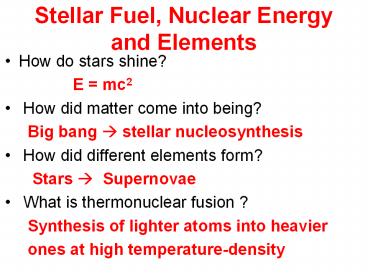Stellar Fuel, Nuclear Energy and Elements - PowerPoint PPT Presentation
Title:
Stellar Fuel, Nuclear Energy and Elements
Description:
Stellar Fuel, Nuclear Energy and Elements How do stars shine? E = mc2 How did matter come into being? Big bang stellar nucleosynthesis How did different elements form? – PowerPoint PPT presentation
Number of Views:122
Avg rating:3.0/5.0
Title: Stellar Fuel, Nuclear Energy and Elements
1
Stellar Fuel, Nuclear Energy and Elements
- How do stars shine?
- E mc2
- How did matter come into being?
- Big bang ? stellar nucleosynthesis
- How did different elements form?
- Stars ? Supernovae
- What is thermonuclear fusion ?
- Synthesis of lighter atoms into heavier
- ones at high temperature-density
2
(No Transcript)
3
The Atomic and Sub-Atomic Zoo
- Atom ? protons, electrons neutrons
- Atomic number (protons)
- Atomic weight (protonsneutrons)
- Hydrogen ? 1H1
- Deuterium ? 1H2 (heavy hydrogen)
- Same element, different nuclei ? isotopes
- Nuclear reactions ? energy
4
Nuclear Fusion H ? Hep-p chain (T gt 15 million
K)
neutrino
Deuterium
positron
Gamma-rays
electron
P.S. No gamma rays produced in the p-p reaction
itself
5
Deuterium (Heavy Hydrogen) Hydrogen ? Light
Helium-3 gamma-rays (energy)
6
Final Product He-3 ? Ordinary He-4 Energy
Helium nucleus is called alpha (a)-particle
7
Future Sun The Red Giant
- When MS star exhausts H in the core and becomes
a Red Giant - Core becomes helium dominated H ? He contracts
and heats - H-burning in outer shell envelope expands and
cools - Helium Flash ? helium burning 3 He ?
C (triple-a nuclear fusion) - 4He2 4He2 4He2 ? 12C6 2g
- 4He2 12C6 ? 16O8
- Helium burning ? Carbon/Oxygen core
8
Solar-type star
9
Main Sequence Lifetime of Solar-type Star
10
Evolution beyond the Red Giant
- L does not increase at the onset of the He-flash
itself since the central region of the core is
quite opaque - The H-burning shell is slowly extinguished and L
decreases, even as the star shrinks and
temperature rises the star moves leftward along
a nearly Horizontal Branch on the H-R diagram - Luminosity rises again as the energy from the
He-burning core of the RG rises to the surface - The star then resumes its climb up the H-R
diagram along a second vertical branch the - Asymptotic Giant Branch (AGB)
11
Low-Mass Stellar Evolution
12
(No Transcript)
13
Evolution Beyond the AGB Phase
- He-burning via the triple-a fusion to carbon is
highly temperature sensitive (T gt 100 million K) - The AGB star is unstable radiation pressure
from the interior push away the envelope hot
core separates from the envelope - Hot core is mainly C-O (products of
triple-alpha) - Hot core is very luminous initially, but rapidly
cools through a Planetary Nebula (PN) phase (NO
relation to planets!) - The PN C-O core surrounded by the brightly lit
ejected envelope appears as a ring - The PN core cools and collapses to White Dwarf
14
(No Transcript)
15
Central Star and Spherical Ejected Shell
16
Cats Eye Planetary Nebula
17
Nucleosynthesis in High Mass Stars
- Nuclear fusion continues beyond C/O
- For example
- 12C6 16O8 ? 28Si14
- 28Si14 28Si14 ? 56Ni28 ? 56Fe26
- Radioactive Ni ? Fe
- Fusion beyond iron is endothermic does not
produce energy stars out of fuel gravity wins
and.
18
The Supernova Onion Rings (or Rings of Tree Stem)
19
High-Mass Stellar Death
- 1.44 M(Sun) ? Chandrashekhar Limit
- If the WD mass is more than 1.44 times more
massive than the Sun, it undergoes a
gravitational Fe-core collapse into a Neutron
Star - Electrons fall into nuclei (protons)
- e- p ? no n (neutrino)
- Gravitational collapse may continue massive
stars end up as neutron stars or black holes
after supernova explosion
20
Pulsating Variable Luminosity StarsInstability
Strip on the HR Diagram
Cepheid stars are Standard Candles
Cepheids used to establish the cosmological
distance scale
21
Period-Luminosity Relation of Variable
Stars Apparent magnitude m vs. Period (days)
22
Longer the period, more luminous the Cepheid
star Determine absolute luminosity M from
period Distance d from m-M 5 log d 5
23
Summary of Stellar Evolution
24
Stellar Evolution HR Diagram
Low Mass Stars Proto-star ? MS ? RG ? AGB ? Pne
? WD High Mass Stars MS ? Variable Cepheids/
Supernovae/Black Holes MS Main
Sequence RG Red Giant AGB Asymptotic Giant
Branch Pne Planetary Nebulae WD White Dwarf
Sne Supernovae
25
Cosmic Abundances
- Big Bang nucleosynthesis produced mainly 90
H, 8 He (by number) - ? primordial H, He abundances
- Not yet known accurately, even in the Sun
- To wit C, N, O abundances revised downwards by
30-50 in the last decade - What is the Sun made of?
- Cosmic abundances relative to the Sun
26
Three Pillars of Big Bang Theory
- Hubbles Law ? Redshift of galaxies
- 2.73 K Cosmic Microwave Background ? Remnant
radiation from the Big Bang - Primordial and fixed ratio of H or D to He ? 90
to 8 by number - N.B. Deuterium is an isotope of hydrogen, also
called heavy hydrogen, with a neutron and
proton in the nucleus and an electron































